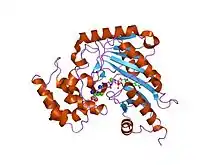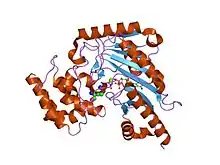ATP:guanido phosphotransferase family
In molecular biology, the ATP:guanido phosphotransferase family is a family of structurally and functionally related enzymes,[1][2] that reversibly catalyse the transfer of phosphate between ATP and various phosphogens. The enzymes belonging to this family include:
- Glycocyamine kinase (EC 2.7.3.1), which catalyses the transfer of phosphate from ATP to guanidoacetate.
- Arginine kinase (EC 2.7.3.3), which catalyses the transfer of phosphate from ATP to arginine.
- Taurocyamine kinase (EC 2.7.3.4), an annelid-specific enzyme that catalyses the transfer of phosphate from ATP to taurocyamine.
- Lombricine kinase (EC 2.7.3.5), an annelid-specific enzyme that catalyses the transfer of phosphate from ATP to lombricine.
- Smc74, a cercaria-specific enzyme from Schistosoma mansoni.[1]
- Creatine kinase (EC 2.7.3.2) (CK),[3][4] which catalyses the reversible transfer of high energy phosphate from ATP to creatine, generating phosphocreatine and ADP.
| ATP:guanido phosphotransferase catalytic domain | |||||||||
|---|---|---|---|---|---|---|---|---|---|
 structure of arginine kinase c271a mutant | |||||||||
| Identifiers | |||||||||
| Symbol | ATP-gua_Ptrans | ||||||||
| Pfam | PF00217 | ||||||||
| Pfam clan | CL0286 | ||||||||
| InterPro | IPR022414 | ||||||||
| PROSITE | PDOC00103 | ||||||||
| SCOP2 | 1crk / SCOPe / SUPFAM | ||||||||
| |||||||||
| ATP:guanido phosphotransferase N-terminal domain | |||||||||
|---|---|---|---|---|---|---|---|---|---|
 transition state structure of an arginine kinase mutant | |||||||||
| Identifiers | |||||||||
| Symbol | ATP-gua_PtransN | ||||||||
| Pfam | PF02807 | ||||||||
| InterPro | IPR022413 | ||||||||
| PROSITE | PDOC00103 | ||||||||
| SCOP2 | 1crk / SCOPe / SUPFAM | ||||||||
| |||||||||
Creatine kinase plays an important role in energy metabolism of vertebrates. There are at least four different, but very closely related, forms of CK. Two isozymes, M (muscle) and B (brain), are cytosolic, while the other two are mitochondrial. In sea urchins there is a flagellar isozyme, which consists of the triplication of a CK-domain. A cysteine residue is implicated in the catalytic activity of these enzymes and the region around this active site residue is highly conserved.
ATP:guanido phosphotransferases contain a C-terminal catalytic domain which consists of a duplication where the common core consists of two beta-alpha-beta2-alpha repeats.[5] The substrate binding site is located in the cleft between N and C-terminal domains, but most of the catalytic residues are found in the larger C-terminal domain.[5] They also contain an N-terminal domain which has an all-alpha fold consisting of an irregular array of 6 short helices.[5]
References
- Stein LD, Harn DA, David JR (April 1990). "A cloned ATP:guanidino kinase in the trematode Schistosoma mansoni has a novel duplicated structure". J. Biol. Chem. 265 (12): 6582–8. PMID 2324092.
- Strong SJ, Ellington WR (January 1995). "Isolation and sequence analysis of the gene for arginine kinase from the chelicerate arthropod, Limulus polyphemus: insights into catalytically important residues". Biochim. Biophys. Acta. 1246 (2): 197–200. doi:10.1016/0167-4838(94)00218-6. PMID 7819288.
- Bessman SP, Carpenter CL (1985). "The creatine-creatine phosphate energy shuttle". Annu. Rev. Biochem. 54: 831–62. doi:10.1146/annurev.bi.54.070185.004151. PMID 3896131.
- Haas RC, Strauss AW (April 1990). "Separate nuclear genes encode sarcomere-specific and ubiquitous human mitochondrial creatine kinase isoenzymes". J. Biol. Chem. 265 (12): 6921–7. PMID 2324105.
- Fritz-Wolf K, Schnyder T, Wallimann T, Kabsch W (May 1996). "Structure of mitochondrial creatine kinase". Nature. 381 (6580): 341–5. doi:10.1038/381341a0. PMID 8692275. S2CID 4254253.